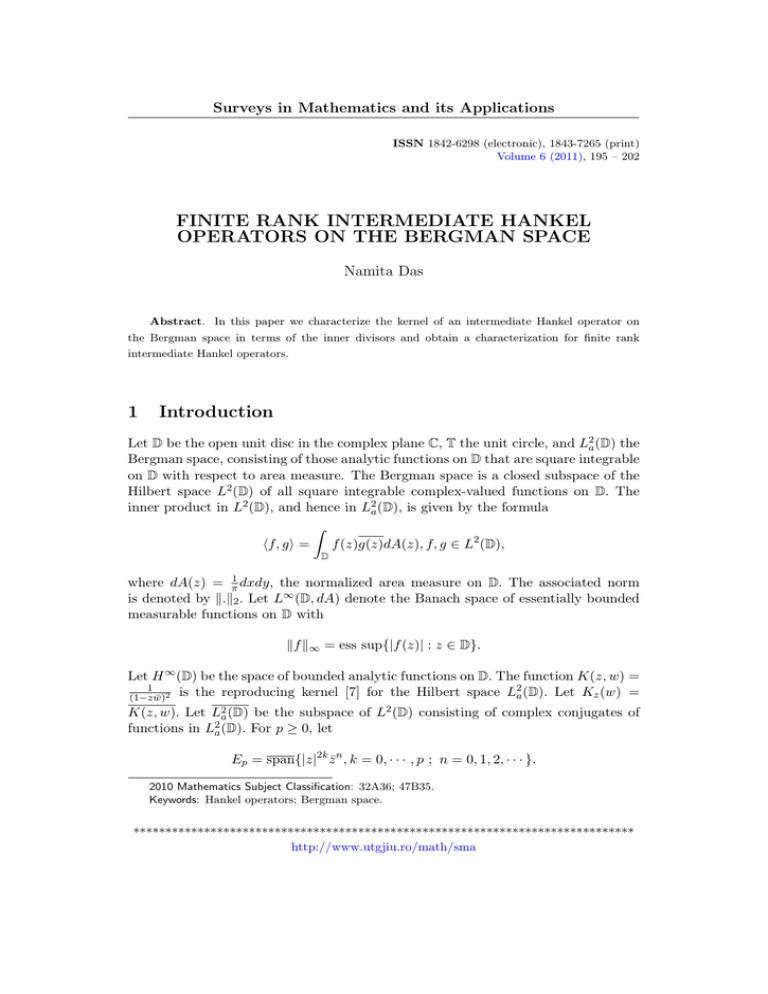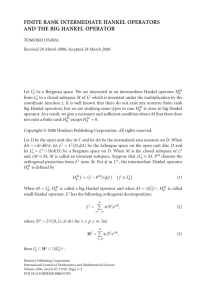FINITE RANK INTERMEDIATE HANKEL OPERATORS ON THE BERGMAN SPACE Namita Das
advertisement

Surveys in Mathematics and its Applications
ISSN 1842-6298 (electronic), 1843-7265 (print)
Volume 6 (2011), 195 – 202
FINITE RANK INTERMEDIATE HANKEL
OPERATORS ON THE BERGMAN SPACE
Namita Das
Abstract. In this paper we characterize the kernel of an intermediate Hankel operator on
the Bergman space in terms of the inner divisors and obtain a characterization for finite rank
intermediate Hankel operators.
1
Introduction
Let D be the open unit disc in the complex plane C, T the unit circle, and L2a (D) the
Bergman space, consisting of those analytic functions on D that are square integrable
on D with respect to area measure. The Bergman space is a closed subspace of the
Hilbert space L2 (D) of all square integrable complex-valued functions on D. The
inner product in L2 (D), and hence in L2a (D), is given by the formula
Z
hf, gi =
f (z)g(z)dA(z), f, g ∈ L2 (D),
D
where dA(z) = π1 dxdy, the normalized area measure on D. The associated norm
is denoted by k.k2 . Let L∞ (D, dA) denote the Banach space of essentially bounded
measurable functions on D with
kf k∞ = ess sup{|f (z)| : z ∈ D}.
Let H ∞ (D) be the space of bounded analytic functions on D. The function K(z, w) =
1
is the reproducing kernel [7] for the Hilbert space L2a (D). Let Kz (w) =
(1−z w̄)2
K(z, w). Let L2a (D) be the subspace of L2 (D) consisting of complex conjugates of
functions in L2a (D). For p ≥ 0, let
Ep = span{|z|2k z̄ n , k = 0, · · · , p ; n = 0, 1, 2, · · · }.
2010 Mathematics Subject Classification: 32A36; 47B35.
Keywords: Hankel operators; Bergman space.
******************************************************************************
http://www.utgjiu.ro/math/sma
196
N. Das
E
For φ ∈ L∞ (D), we define the intermediate Hankel operator Hφ p : L2a → Ep by
E
Hφ p (f ) = Pp (φf ), f ∈ L2a where Pp is the orthogonal projection from L2 (D) onto
Ep . Note L2a ⊆ Ep ⊆ ((L2a )0 )⊥ where (L2a )0 = {g ∈ L2a : g(0) = 0}.
In this paper we characterize the kernel of an intermediate Hankel operator in
terms of the inner divisors of the Bergman space and obtain a characterization for
finite rank intermediate Hankel operators. Similar characterizations for finite rank
intermediate Hankel operators were also obtained by E. Strouse [6] using different
techniques. We use the invariant subspace theory for the Bergman space developed
in [2],[3] and [4].
2
Intermediate Hankel operators
For p ≥ 0, let Ep be the closed subspace of L2 (D) described above. For n > m and
j ∈ {0, · · · , p}, let
Q
Y
1
1≤l≤p+1 (n − m + l + j)
n,m
Q
Aj =
(m − l).
j!(p − j)!(−1)p−j
1≤l≤p+1 (n + l)
0≤l≤p
l6=j
It is not so difficult to check that
0 if
z̄ n z m if
Pp (z̄ z ) =
n−m+1 z+
An,m z̄ n−m + An,m
1 z̄
0
n,m n−m+p p
z if
· · · + Ap z̄
n m
n < m;
n ≥ m, 0 ≤ m ≤ p;
n ≥ m, m > p.
The details are given in [6, Lemma 1].
E
Lemma 1. Suppose φ ∈ L∞ (D). The operator Hφ p ≡ 0 if and only if φ ∈ Ep⊥ .
E
Proof. Note Hφ p = 0 implies φf ∈ Ep⊥ for all f ∈ L2a (D) and hence in particular
φ ∈ Ep⊥ . Conversely, if φ ∈ Ep⊥ then hφ, |z|2k z̄ n i = 0 for all n ∈ Z, n ≥ 0, and
k = 0, 1, · · · , p.
Let f ∈ L2a (D) and g ∈ Ep and g(z) = |z|2k z̄ n , n = 0, 1, 2, · · · ; k = 0, 1, · · · , p. Then
E
E
hHφ p f, gi = hPp (φf ), gi = hφf, gi = hφ, f¯gi = 0 as f¯g ∈ Ep . This implies Hφ p f = 0
E
for all f ∈ L2a (D) and thus Hφ p ≡ 0.
E
Proposition 2. If Q : L2 → L2a is the Bergman projection, then (Hφ p )∗ = Q(φ̄f ).
E
E
Proof. If f ∈ Ep , g ∈ L2a then h(Hφ p )∗ f, gi = hf, Hφ p gi = hf, Pp (φg)i = hf, φgi =
E
E
hφ̄f, gi = hQ(φ̄f ), gi. Thus (Hφ p )∗ : Ep → L2a such that (Hφ p )∗ f = Q(φ̄f ).
******************************************************************************
Surveys in Mathematics and its Applications 6 (2011), 195 – 202
http://www.utgjiu.ro/math/sma
197
Hankel operators on the Bergman space
3
Inner functions and kernel of a finite rank intermediate
Hankel operator
Definition 3. An invariant subspace of L2a (D) is a closed subspace I such that
zI ⊂ I; in other words zf (z) is in I whenever f is in I.
Definition 4. A function G ∈ L2a (D) (G ∈ H 2 ) is called an inner function in
L2a (D)(respectively, H 2 ) if |G|2 − 1 is orthogonal to H ∞ .
This definition of inner function in a Bergman space was given by Korenblum and
Stessin [5]. If N is a subspace of L2a (D), let Z(N ) = {z ∈ D : f (z) = 0 for all f ∈ N },
which is called the common zero set of functions in N. Hence if z1 is a zero of
multiplicity at most n of all functions in N, then z1 appears n times in the set
Z(N ), and each z1 is treated as a distinct element of Z(N ).
Lemma 5. If I is an invariant subspace of L2a (D) of finite codimension and Z(I) =
{z ∈ D : f (z) = 0 for all f ∈ I} then Z(I) is a finite set and I = I(Z(I)) = {f ∈
L2a (D) : f (z) = 0 for all z ∈ Z(I)}.
Proof. For proof see [1].
For notational convenience, henceforth we shall assume that p is a fixed positive
integer.
E
Theorem 6. Let φ ∈ L∞ (D) and Hφ p be a finite rank intermediate Hankel operator
E
on L2a (D). Then kerHφ p = GL2a (D) for some inner function G ∈ L2a (D) and the
following hold.
E
p
(i) If a = {aj }N
j=1 = Z(kerHφ ) then G vanishes on a.
(ii) kGkL2 = 1 and G is equal to a constant plus a linear combination of the
Bergman kernel functions K(z, a1 ), K(z, a2 ), · · · , K(z, an ) and certain of their
derivatives.
(iii) |G|2 − 1 ⊥ L1h where L1h is the class of harmonic functions in L1 of the disc.
E
E
Proof. Note kerHφ p = {f ∈ L2a (D) : Hφ p f = 0} = {f ∈ L2a (D) : Pp (φf ) = 0} =
{f ∈ L2a (D) : φf ∈ Ep⊥ } = {f ∈ L2a (D) : hφf, |z|2k z̄ n i = 0 for all n ∈ Z, n ≥
0 and k = 0, 1, · · · , p}.
E
Now if f ∈ kerHφ p then hφf, |z|2k z̄ n i = 0 for all n ∈ Z, n ≥ 0 and k = 0, 1, · · · , p and
therefore hzφf, |z|2k z̄ n i = hφf, |z|2k z̄ n+1 i = 0 for all n ∈ Z, n ≥ 0 and k = 0, 1, · · · , p.
E
E
Hence zφf ∈ Ep⊥ and then zf ∈ kerHφ p . Thus kerHφ p ⊂ L2a is invariant under
******************************************************************************
Surveys in Mathematics and its Applications 6 (2011), 195 – 202
http://www.utgjiu.ro/math/sma
198
N. Das
E
E
multiplication by z, and kerHφ p has finite codimension since Hφ p is of finite rank.
E
Let Z(kerHφ p ) = a = {aj }N
j=1 . Let G be the extremal function for the problem
sup{Ref (k) (0) : f ∈ L2a , kf kL2 ≤ 1, f = 0 on a},
where k is the multiplicity of the number of times zero appears in a = {aj }N
j=1 (k = 0
N
if 0 ∈
/ {aj }j=1 ). It is clear from [2, 3, 4] that G satisfies conditions (i)-(iii), and G
vanishes precisely on a in D, counting multiplicities. Moreover, for every function
2
f ∈ L2a (D) that vanishes on a = {aj }N
j=1 , there exists g ∈ La (D) such that f = Gg.
E
Thus kerHφ p = GL2a (D).
E
E
If Hφ p is of finite rank, then rankHφ p = number of zeroes of G counting multiplicities.
We now make the link between inner functions and finite rank Hankel operators as
follows.
E
Proposition 7. Suppose Ψ ∈ L∞ (D) and HΨ p is a finite rank intermediate Hankel
operator. Then there exist functions φ and χ such that Ψ = φ + χ, where χ ∈ Ep⊥
and φ̄z k ∈ Ep ∩(GL2a )⊥ , for all k = 0, 1, · · · , p and for some inner function G ∈ H ∞ .
E
Proof. Suppose Ψ ∈ L∞ (D) and HΨ p is a finite rank intermediate Hankel operator.
E
E
E
Let Ψ = φ+χ, where χ ∈ Ep⊥ and φ ∈ Ep . By Lemma 1, Hχ p ≡ 0. Hence HΨ p ≡ Hφ p
E
and therefore, Hφ p is a finite rank intermediate Hankel operator.
E
By Theorem 6, there exists an inner function G ∈ L2a (D) such that kerHφ p =
GL2a (D). Thus φG ∈ Ep⊥ . So hφG, hi = 0 for all h ∈ Ep . That is, hGh̄, φ̄i = 0
⊥
for all h ∈ Ep , and so Ψ̄ = φ̄ + χ̄, where χ̄ ∈ Ep and φ̄ ∈ Ep ∩ (GEp )⊥ . By
Theorem 6, G vanishes precisely at a = {aj }N
j=1 , a finite sequence of points in D,
⊥
counting multiplicities. Now φ̄ ∈ Ep ∩ (GEp ) implies hφ̄, G|z|2k z n i = 0 for all k =
0, 1, · · · p, n ∈ Z, n ≥ 0. Hence hφ̄z k , Gz k+n i = 0 for all k = 0, 1, · · · p, n ∈ Z, n ≥ 0.
Thus φ̄z k ∈ Ep ∩ (GL2a )⊥ for all k = 0, 1, · · · p.
E
Corollary 8. If Ψ ∈ H ∞ and HΨ p is of finite rank then for all k = 0, 1, · · · p,
k
Ψ̄z =
j −1
N m
X
X
j=1 ν=0
(k)
cjν
∂ν
Kb (z)
∂ b̄νj j
(k)
where cjν are constants for all k = 0, 1, · · · p and j = 1, · · · , N and ν = 0, · · · mj − 1.
Here b = {bj }N
j=1 is a finite set of points in D and mj is the number of times bj
appears in b.
******************************************************************************
Surveys in Mathematics and its Applications 6 (2011), 195 – 202
http://www.utgjiu.ro/math/sma
199
Hankel operators on the Bergman space
Proof. By Proposition 7, Ψ = φ + χ, where χ ∈ Ep⊥ and φ̄z k ∈ Ep ∩ (GL2a )⊥ , for
all k = 0, 1, · · · , p and for some inner function G ∈ H ∞ . Since Ψ ∈ H ∞ , χ ≡ 0.
Thus HΨ ≡ Hφ is a finite rank operator and Ψz k = φz k ∈ Ep ∩ (GL2a )⊥ , for all
E
k = 0, 1, · · · , p and for some inner function G ∈ H ∞ . Further, kerHΨ p = GL2a (D).
Now Ψz k ∈ L2a ⊂ Ep . Thus Ψz k ∈ L2a ∩ Ep ∩ (GL2a )⊥ = L2a GL2a . Let b = {bj }N
j=1
be the zeros of G (counting multiplicities). From [2, 4], it follows that
{Kb1 , · · · ,
∂ m1 −1
∂ mN −1
KbN }
m1 −1 Kb1 , · · · , KbN , · · · ,
N −1
∂ b̄1
∂ b̄m
N
form a basis for (GL2a (D))⊥ , hence the result follows.
E
Notice that Ψ is a polynomial of degree ≤ p if and only if rankHΨ p ≤ p. The
proof of this fact is given in [6]. For the sake of completeness, we are presenting
the proof of [6] here: If Ψ is a polynomial of degree less than or equal to p then
E
rankHΨ p ≤ p. This is so because if Ψ(z) = a0 + a1 z + · · · + ak z k , k ≤ p, ak 6= 0 then
E
for m > k, HΨ p (z m ) = Pp (Ψz m ) = Pp ((a¯0 + a¯1 z̄ + · · · + a¯k z̄ k )z m ) = 0. If Ψ ∈ L2a
P∞ |Ψ̂(n)|2
P
Ep
n
then (see [7]), Ψ(z) = ∞
n=0 n+1 < ∞. Now if HΨ
n=0 Ψ̂(n)z̄ , Ψ̂(n) ∈ C and
E
E
is of rank ≤ p and Ψ is not a polynomial then the functions HΨ p (1) = Ψ, HΨ p (z) =
Pp−1
E
Ψ̂(n)z̄ n ) are linearly independent and
z(Ψ − Ψ̂(0)), · · · , HΨ p (z p ) = z p (Ψ − n=0
P
Ep
z̄ k+j z j . Notice
rankHΨ ≥ p + 1 which is a contradiction. Let vk = pj=o Am+k,m
j
E
E
that vk ⊥ vl for k 6= l. Now if for some m ≥ 0, HΨ p (z m ) = 0 then since HΨ p (z m ) =
P∞
Pp
m+k,m k+j j
z̄ z ); hence Ψ̂(m + k) = 0 for all k = 0, 1, 2, · · · .
k=o Ψ̂(m + k)( j=o Aj
E
This implies Ψ is a polynomial of degree ≤ m and in which case HΨ p (z n ) = 0 for
E
all n ≥ m. Thus rankHΨ p ≤ p implies Ψ is a polynomial of degree ≤ p.
E
Theorem 9. If Ψ ∈ (Ep )⊥ ⊕H ∞ and HΨ p is a finite rank operator of rank p+r then
E
Ψ = χ + Θ + φ where χ ∈ (Ep )⊥ , Θ is a polynomial of degree ≤ p, and rankHφGp 1 ≤ r
for some inner function G1 .
E
Proof. Suppose Ψ ∈ (Ep )⊥ ⊕H ∞ and HΨ p is a finite rank operator of rank p+r. Then
Ψ = χ + Ω where χ ∈ (Ep )⊥ and Ω ∈ H ∞ . Since Hχ̄ ≡ 0 if and only if χ ∈ (Ep )⊥ ,
E
E
hence HΨ p = HΩ p is a finite rank operator of rank p + r. By Theorem 6 this implies
E
there exists an inner function (a finite zero divisor) G ∈ H ∞ such that kerHΩ p =
E
GL2a (D). Let Z(kerHΩ p ) = {ξj }N
j=1 repeated according to their multiplicities. From
1
[2, 3, 4], it follows that G(z) = J(0, 0)− 2 B(z)J(z, 0), where J(z, ζ) is the kernel
function of the Bergman space L2a (w(z)dA(z)) with weight w = |B|p , and B is the
finite Blaschke product associated with {ξj }N
j=1 . Without loss of generality assume
Q
|ξn | ξn −z
that G has no zeros at the origin. That is, B(z) = N
n=1 ξn 1−ξ z . Let B1 (z) =
n
******************************************************************************
Surveys in Mathematics and its Applications 6 (2011), 195 – 202
http://www.utgjiu.ro/math/sma
200
N. Das
QN
|ξn | ξn −z
|ξn | ξn −z
− 12
B(z)J(z, 0) =
n=1 ξn 1−ξn z and B2 (z) =
n=p+1 ξn 1−ξn z . Then G(z) = J(0, 0)
− 21
J(0, 0) B1 (z)J(z, 0)B2 (z) = G1 (z)B2 (z) where G1 (z) is an inner function in the
Bergman space L2a (D) and B2 (z) is a classical inner function , in fact a finite Blaschke
Qp
product. Notice that G1 has p zeros and B2 has N − p zeros counting multiplicities.
E
E
Now kerHΩ p = GL2a (D) implies HΩ p (GL2a ) = {0}. Hence, ΩG ∈ (Ep )⊥ . That is,
Ω ∈ (GEp )⊥ or Ω ∈ (GEp )⊥ . But observe that (GEp )⊥ = (G1 Ep )⊥ ⊕ [(GEp )⊥ (G1 Ep )⊥ ] = (G1 Ep )⊥ ⊕ [(GEp )⊥ ∩ G1 Ep ]. Thus, Ω = Θ + φ where Θ ∈ (G1 Ep )⊥ and
E
E
E
E
φ ∈ (GEp )⊥ ∩ G1 Ep . Hence HΩ p = HΘ p + Hφ p . We shall now verify that HΘ p is a
E
finite rank operator of rank ≤ p and rankHφGp 1 ≤ r.
E
Since Θ ∈ (G1 Ep )⊥ , we have ΘG1 ∈ (Ep )⊥ and hence kerHΘ p ⊃ G1 L2a . Thus
E
∗ Ep ⊂ (G L2 )⊥ ∩ L2 . Since G L2 ⊂ L2 and (G L2 )⊥ has
(kerHΘ p )⊥ = rangeHΘ
1 a
1 a
1 a
a
a
E
E
dimension p; the space kerHΘ p has finite codimension and dim range HΘ p ≤ p.
∞
Hence Θ is a polynomial of degree ≤ p. Thus Θ ∈ H and therefore φ̄ ∈ H ∞ . Now
φ̄ ∈ (GEp )⊥ ∩ G1 Ep . This implies φ̄ ∈ G1 Ep and φ̄ ⊥ GEp . That is, hφ̄G1 , B2 gi =
hφ̄, G1 B2 gi = hφ̄, Ggi = 0 for all g ∈ Ep . Thus φ̄G1 ∈ (B2 Ep )⊥ . That is, φG1 ∈
E
(B2 Ep )⊥ . Hence rankHφGp 1 ≤ r.
E
E
Theorem 10. If Hφ p is an intermediate Hankel operator on L2a (D), and kerHφ p =
{f ∈ L2a (D) : f = 0 on b} where b = {bj }∞
j=1 is an infinite sequence of points in D,
E
then there exists an inner function G ∈ L2a (D) such that kerHφ p = GL2a (D) ∩ L2a (D).
E
Proof. The proof follows from the result of Hedenmalm [4] as kerHφ p is an invariant
subspace of the operator of multiplication by z.
It is not known for the Bergman space whether the invariant subspaces determined
by infinite zero sets are generated by the corresponding canonical divisors (see [2, 4]).
Now let b = {bj }∞
j=1 be an infinite sequence of points in D. Let I = I(b) = {f ∈
2
La (D) : f = 0 on b}. Let Gb be the solution of the extremal problem
sup{Ref (n) (0) : f ∈ I, kf kL2 ≤ 1},
(3.1)
where n is the number of times zero appears in the sequence b(that is, the functions
in I have a common zero of order n at the origin). The natural question that arises
at this point is to see if it is possible to construct an intermediate Hankel operator
E
Hφ p whose kernel is Gb L2a ∩ L2a . In the case that b = {bj }N
j=1 is a finite set of points
E
in D, it is possible to construct an intermediate Hankel operator Hφ p such that
E
kerHφ p = Gb L2a (D), as follows.
2
Theorem 11. If b = {bj }N
j=1 is a finite set of points in D, I = I(b) = {f ∈ La (D) :
******************************************************************************
Surveys in Mathematics and its Applications 6 (2011), 195 – 202
http://www.utgjiu.ro/math/sma
201
Hankel operators on the Bergman space
f = 0 on b} and Gb is the solution of the extremal problem (3.1),
k
φ̄z =
j −1
N m
X
X
j=1 ν=0
(k)
(k)
cjν
∂ν
Kb (z)
∂ b̄νj j
(k)
where cjν are constants, cjν 6= 0 for all j, ν, k = 0, 1, · · · , p and mj is the number
E
of times bj appears in b, then kerHφ p = Gb L2a (D).
Proof. {Kb1 , · · · ,
∂ m1 −1
m −1 Kb1 , · · ·
∂ b̄1 1
, KbN , · · · ,
∂ mN −1
m −1 KbN }
∂ b̄N N
forms a basis for (Gb L2a (D))⊥ .
By the Gram-Schmidt orthogonalization process, we can obtain an orthonormal basis
{Ψj }lj=1 for (Gb L2a )⊥ . Since φ̄z k ∈ (Gb L2a )⊥ , hence hφ̄z k , Gb z n z k i = 0 for all k =
0, 1, · · · , p, n ∈ Z, n ≥ 0. This implies hφ̄, Gb |z|2k z n i = 0 for all k = 0, 1, · · · , p, n ∈
Z, n ≥ 0. Therefore h|z|2k z̄ n , φGb i = 0 for all k = 0, 1, · · · , p, n ∈ Z, n ≥ 0. Thus
E
E
φGb ∈ Ep⊥ and Gb ∈ kerHφ p . Since kerHφ p is invariant under the operator of
multiplication by z, hence
E
Gb L2a ⊂ kerHφ p .
(3.2)
E
Suppose f ∈ kerHφ p , then φf ∈ Ep⊥ . That is, hφf, |z|2k z̄ n i = 0 for all n ≥
0, n ∈ Z, k = 0, 1, · · · , p. Hence h|z|2k φf, z̄ n i = 0 for all n ≥ 0, n ∈ Z, k = 0, 1, · · · , p
and therefore h|z|2k φf, ḡi = 0 for all g ∈ L2a and k = 0, 1, · · · , p. So in particular,
h|z|2k φf, Kbj i = 0 for all j = 1, 2, · · · , N ; k = 0, 1, · · · , p. Thus φ(bj )|bj |2k f (bj ) = 0
for all j = 1, 2, · · · , N ; k = 0, 1, · · · , p. In particular, φ(bj )f (bj ) = 0 for all j =
1, 2, · · · , N.
Since φ(bj ) 6= 0 for all j = 1, 2, · · · , N hence we have, f (bj ) = 0 for all j =
1, 2, · · · , N. Thus f ∈ I. Since Gb is the solution of the extremal problem (1),
f ∈ Gb L2a . Hence
E
(3.3)
kerHφ p ⊂ Gb L2a .
E
From (3.2) and (3.3), kerHφ p = Gb L2a = I as required.
References
[1] N. Das, The kernel of a Hankel operator on the Bergman space, Bull. London
Math. Soc. 31 (1999), 75-80. MR1651001(99j:47034). Zbl 0942.47015.
[2] P. L. Duren, D. Khavinson, H.S. Shapiro and C. Sundberg, Contractive
zero-divisors in Bergman spaces, Pacific J. Math. 157 (1993), 37-56.
MR1197044(94c:30048). Zbl 0739.30029.
******************************************************************************
Surveys in Mathematics and its Applications 6 (2011), 195 – 202
http://www.utgjiu.ro/math/sma
202
N. Das
[3] P.L. Duren, D. Khavinson, H. S. Shapiro and C. Sundberg, Invariant subspaces
in Bergman spaces and the biharmonic equation, Michigan Math. J. 41 (1994),
247-259. MR1278431(95e:46030). Zbl 0833.46044.
[4] H. Hedenmalm, A factorization theorem for square area-integrable analytic
functions, J. Reine. Angew. Math. 422 (1991), 45-68. MR1133317(93c:30053).
Zbl 0734.30040.
[5] B. Korenblum and M. Stessin, On Toeplitz-invariant subspaces of the Bergman
space, J. Funct. Anal. 111 (1993), 76-96. MR1200637(94f:30049). Zbl 0772.30042.
[6] E. Strouse, Finite rank intermediate Hankel operators, Arch. Math. (Basel) 67
(1996), 142-149. MR1399831(97i:47047). Zbl 0905.47014.
[7] K. Zhu, Operator theory in function spaces, Monographs and Textbooks in Pure
and Applied Mathematics, Marcell Dekker, Inc. 139, New York and Basel, 1990.
MR1074007(92c:47031). Zbl 0706.47019.
Namita Das
P. G. Dept. of Mathematics,
Utkal University, Vanivihar, Bhubaneswar,
751004, Orissa, India.
e-mail: namitadas440@yahoo.co.in
******************************************************************************
Surveys in Mathematics and its Applications 6 (2011), 195 – 202
http://www.utgjiu.ro/math/sma







